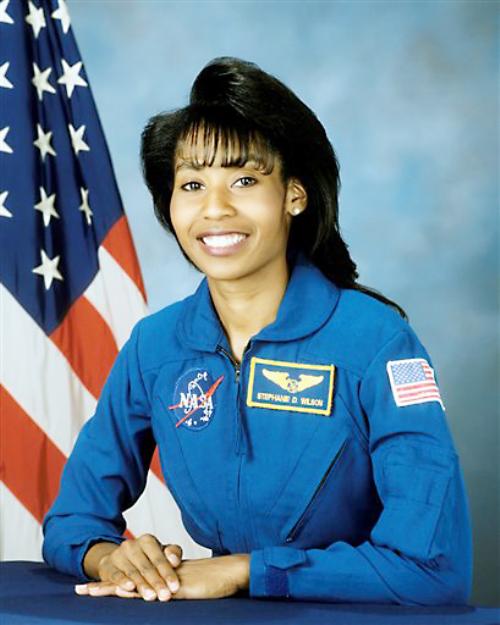
News
Pro-Palestine Encampment Represents First Major Test for Harvard President Alan Garber

News
Israeli PM Benjamin Netanyahu Condemns Antisemitism at U.S. Colleges Amid Encampment at Harvard

News
‘A Joke’: Nikole Hannah-Jones Says Harvard Should Spend More on Legacy of Slavery Initiative

News
Massachusetts ACLU Demands Harvard Reinstate PSC in Letter

News
LIVE UPDATES: Pro-Palestine Protesters Begin Encampment in Harvard Yard
Graduate To Launch On NASA Shuttle
Currier House alum will be the second black woman in outer space

All eyes will be on the sky Saturday at NASA’s Kennedy Space Center when rookie astronaut Stephanie D. Wilson ’88, a former engineering concentrator from Currier House, embarks on her inaugural mission aboard the Space Shuttle Discovery.
Wilson, who will be the second African-American woman in space, will serve as mission specialist to the seven-person Discovery crew. The upcoming mission will be NASA’s second shuttle flight since losing the Space Shuttle Columbia and its crew of seven in 2003.
In a pre-flight interview with NASA, Wilson, a Boston-bred native, said that she has harbored aeronautic ambitions since the age of 13. A high school assignment later brought her in contact with local astronomer and former Harvard lecturer Jay M. Pasachoff ’63, and her interest in space skyrocketed from there.
Wilson pursued her undergraduate studies at Harvard’s Division of Engineering and Applied Sciences (DEAS), and was one of only a handful of students from her class to graduate with a bachelors in science degree.
As a tribute to her alma mater, Wilson plans to carry a DEAS flag with her into space and deliver it back to Harvard after the mission, fellow NASA Astronaut Sandra H. Magnus said.
Dean of Engineering and Applied Sciences Venkatesh “Venky” Narayanamurti said Wilson’s upcoming mission “brings great credit” to DEAS.
“We are all going to be rooting for her and a successful flight,” he added, recalling that Wilson returned to the division in April 2004 to discuss her career and experiences at NASA.
During the 12-day undertaking, crew members of flight STS-121 will test new equipment and techniques geared toward enhancing shuttle safety. They will also perform maintenance at the International Space Station (ISS), unload over two tons of supplies, and deliver European astronaut Thomas Reiter.
Wilson will help operate the shuttle’s robot arm, which includes a special extension equipped with new cameras and laser scanners to assess the vehicle’s health. As the load master, Wilson will maneuver the mechanical appendage to deploy and retrieve cargo packages from to and from the space station.
Magnus, who has pulled night shifts and worked in Mission Control with Wilson, said that Wilson’s upcoming task is a “very large logistics problem” that requires a great deal of practice and attention to detail. But she believes Wilson is up for the challenge.
“Stephanie is the hardest working person I have ever met,” Magnus said. “She will do everything correct and won’t let anyone on the team down.”
Wilson received her master of science degree from the University of Texas and was selected as one of 35 Americans to join NASA’s class of 1996. At the Johnson Space Center in Houston, TX, Wilson has worked in Mission Control as a capsule communicator (CAPCOM) for orbiting space crews. In 2003, she served as lead CAPCOM for the ill-fated Columbia mission.
Columbia disintegrated during its re-entry into the Earth’s atmosphere due to the failure of its heat shield. The shield was damaged during the initial launch by a loose fragment of foam. The space shuttle Discovery’s last mission, which was launched one year ago, also shed foam debris during its launch but landed without major complications.
NASA has yet to find a sure-fire solution to the foam-loss issue, but top officials gave their final approval earlier this month for tomorrow’s 3:49 p.m. launch.
Magnus said that every space mission harbors notable hazards—including a 1-in-100 chance of a fatal disaster, according to official NASA estimates—but that the spacecraft set to launch tomorrow incorporates numerous fine-tuned enhancements that address problems plaguing past missions.
“We do everything we can to control the factors we can control and smartly accept the risks that are left,” she added.
Wilson was initially assigned to fly for the first time in 2004 aboard the Space Shuttle Endeavor on flight STS-120, a mission that was postponed after the Columbia tragedy to at least 2007. Wilson was bumped up to STS-121 when the mission was added to the flight schedule, according to NASA reports.
“The improvements that we gained from our work in space, all of those improvements come back to improve life here on Earth,” Wilson said in the NASA interview. “I think there are great benefits to the work that we’re doing, and it’s just very worthwhile and worth the risk.”
President of the Association of Black Harvard Women Natasha S. Alford ’08 said there is a dearth of African American women advancing in the areas of science and engineering and that Wilson’s upcoming aeronautic endeavor will help encourage more black women to enter those areas.
“Her being out there and people knowing about what she’s doing adds to the visibility African-American women in science,” Alford said. “And visibility is the most significant factor that can contribute to the participation of African American women in the field.”
—Staff writer Ying Wang can be reached at yingwang@fas.harvard.edu.
Want to keep up with breaking news? Subscribe to our email newsletter.
